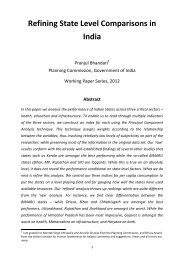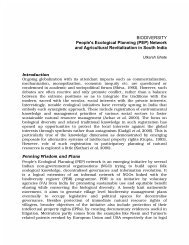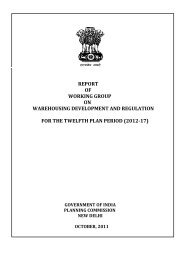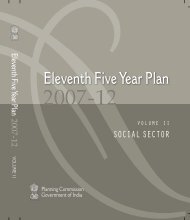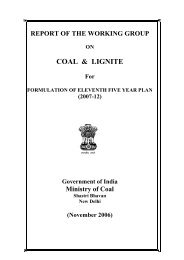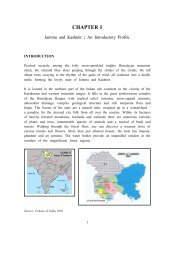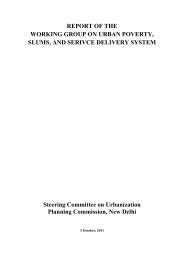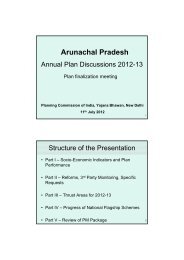Approach Paper for the Twelfth Five Year Plan - of Planning ...
Approach Paper for the Twelfth Five Year Plan - of Planning ...
Approach Paper for the Twelfth Five Year Plan - of Planning ...
You also want an ePaper? Increase the reach of your titles
YUMPU automatically turns print PDFs into web optimized ePapers that Google loves.
34 <strong>Approach</strong> to <strong>the</strong> <strong>Twelfth</strong> <strong>Five</strong> <strong>Year</strong> <strong>Plan</strong><br />
Capacity Creation<br />
3.26 The Eleventh <strong>Plan</strong> had targeted creation <strong>of</strong> 78.7 GW <strong>of</strong> additional capacity <strong>for</strong> grid power. Actual<br />
realization may not exceed 50 GW, largely on account <strong>of</strong> slippages in public sector projects. The shortfall<br />
in achieving <strong>the</strong> targets has been primarily due to poor project implementation, inadequate domestic<br />
manufacturing capacity, shortage <strong>of</strong> power equipment, and slow-down due to lack <strong>of</strong> fuel, particularly coal.<br />
More than 80,000 MW <strong>of</strong> new power capacity is already under construction. Hence it may be reasonable<br />
to target 1,00,000 MW <strong>of</strong> new power capacity during <strong>the</strong> next <strong>Plan</strong>. This will, however, need an effective<br />
resolution <strong>of</strong> issues holding up domestic production <strong>of</strong> coal and effective measures <strong>for</strong> improving financial<br />
health <strong>of</strong> power utilities. The <strong>Twelfth</strong> <strong>Plan</strong> should, <strong>the</strong>re<strong>for</strong>e, aim at capacity creation <strong>of</strong> about 100 GW,<br />
which will include 28 GW <strong>of</strong> capacity from projects which were supposed to be completed in <strong>the</strong> Eleventh<br />
<strong>Plan</strong>, but are now expected to be completed in <strong>the</strong> first two years <strong>of</strong> <strong>the</strong> <strong>Twelfth</strong> <strong>Plan</strong>. We must ensure that<br />
not only <strong>the</strong> spill-over projects from <strong>the</strong> Eleventh <strong>Plan</strong> are completed at <strong>the</strong> earliest, but that slippages<br />
in <strong>the</strong> capacity addition programme <strong>for</strong> <strong>the</strong> <strong>Twelfth</strong> <strong>Plan</strong> are minimised. In addition, we should examine<br />
whe<strong>the</strong>r it is possible to back additional gas-based power capacity <strong>for</strong> initiation/completion during <strong>the</strong><br />
<strong>Twelfth</strong> <strong>Plan</strong>, given <strong>the</strong> competing demand from <strong>the</strong> fertiliser sector.<br />
3.27 The share <strong>of</strong> <strong>the</strong> private sector in capacity expansion has gone up substantially in <strong>the</strong> Eleventh <strong>Plan</strong><br />
and it is expected that 33.0 per cent <strong>of</strong> <strong>the</strong> total incremental capacity will come from <strong>the</strong> private sector.<br />
In <strong>the</strong> <strong>Twelfth</strong> <strong>Plan</strong>, this share is expected to increase fur<strong>the</strong>r to about 50.0 per cent. Since most <strong>of</strong> <strong>the</strong> new<br />
power capacity will consist <strong>of</strong> <strong>the</strong>rmal plants, it is essential to ensure that coal availability does not become<br />
a constraint. This is a serious problem as discussed below.<br />
3.28 India has a substantial potential <strong>for</strong> creating hydropower capacity, especially in <strong>the</strong> North Eastern<br />
region. The pace <strong>of</strong> capacity creation in this area has been slow and it is vital that special emphasis be given<br />
to expedite environmental and o<strong>the</strong>r clearances, so that <strong>the</strong> pace <strong>of</strong> work on <strong>the</strong>se hydro-electric power<br />
projects can be stepped up. Early completion <strong>of</strong> <strong>the</strong>se projects will also generate an income stream <strong>for</strong> <strong>the</strong><br />
North Eastern States which will enable <strong>the</strong>m to accelerate <strong>the</strong> pace <strong>of</strong> development.<br />
3.29 It is also necessary to take measures to increase <strong>the</strong> share <strong>of</strong> gas based power and also <strong>of</strong> nuclear<br />
power. Safeguards in respect <strong>of</strong> <strong>the</strong> latter will be fur<strong>the</strong>r reviewed and additional measures taken as<br />
required. Both <strong>the</strong>se are areas with great potential and will need investments.<br />
Transmission<br />
3.30 In order to support <strong>the</strong> large expansion in production and consumption <strong>of</strong> electricity, <strong>the</strong><br />
transmission and distribution network will have to be significantly expanded and streng<strong>the</strong>ned. Some<br />
private sector investments have been made in transmission in <strong>the</strong> Eleventh <strong>Plan</strong> and it is important to build<br />
a policy framework within which more private sector investments will be <strong>for</strong>thcoming in <strong>the</strong> <strong>Twelfth</strong> <strong>Plan</strong>.<br />
A special project on power evacuation from <strong>the</strong> North-East will have to be undertaken. The possibility<br />
<strong>of</strong> such lines passing through Bangladesh could be considered reflecting our mutually beneficial interdependence.<br />
Technological development <strong>for</strong> transmission lines <strong>of</strong> 765 KV and over 1,000/1,200 KV is <strong>of</strong><br />
great relevance in order to reduce land requirement and also transmission losses.<br />
Distribution<br />
3.31 The distribution segment in <strong>the</strong> power sector is clearly <strong>the</strong> weakest link in <strong>the</strong> power system. The<br />
current losses <strong>of</strong> distribution utilities be<strong>for</strong>e accounting <strong>for</strong> State subsidy are approximately Rs. 70,000



